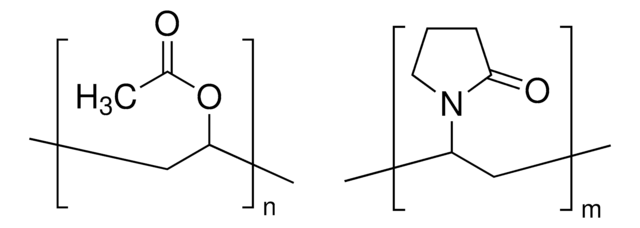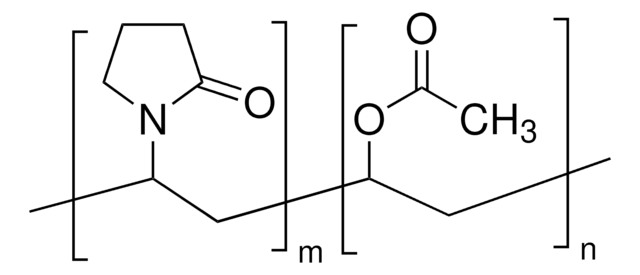02286
Kollidon® 25
Synonym(s):
Polyvinylpyrrolidone, PVP, Polyvidone, Povidone
About This Item
Recommended Products
Quality Level
impurities
≤1 ppm hydrazine
≤10 ppm heavy metals (verified on random samples only)
≤10 ppm lead (verified on random samples only)
≤10 ppm vinylpyrrolidinone
≤3.0% 2-pyrrolidone
≤400 ppm peroxides (as H2O2)
≤5.0% water
≤500 ppm aldehydes (as acetaldehyde)
≤5000 ppm formic acid
12.0-12.8% nitrogen (anhydrous basis)
ign. residue
≤0.1% (verified on random samples only)
pH
3.0-5.0
suitability
complies for Infrared spectrum
application(s)
sample preservation
SMILES string
C=CN1CCCC1=O
InChI
1S/C6H9NO/c1-2-7-5-3-4-6(7)8/h2H,1,3-5H2
InChI key
WHNWPMSKXPGLAX-UHFFFAOYSA-N
Looking for similar products? Visit Product Comparison Guide
Application
Kollidon SR is a blend of polyvinyl acetate and povidone (K 30) in the ratio 8:2 for use as matrix-forming agent. This research grade product is intended for use in R&D and development only.
Other Notes
Legal Information
Storage Class Code
11 - Combustible Solids
WGK
WGK 1
Flash Point(F)
Not applicable
Flash Point(C)
Not applicable
Certificates of Analysis (COA)
Search for Certificates of Analysis (COA) by entering the products Lot/Batch Number. Lot and Batch Numbers can be found on a product’s label following the words ‘Lot’ or ‘Batch’.
Already Own This Product?
Find documentation for the products that you have recently purchased in the Document Library.
Customers Also Viewed
Our team of scientists has experience in all areas of research including Life Science, Material Science, Chemical Synthesis, Chromatography, Analytical and many others.
Contact Technical Service


